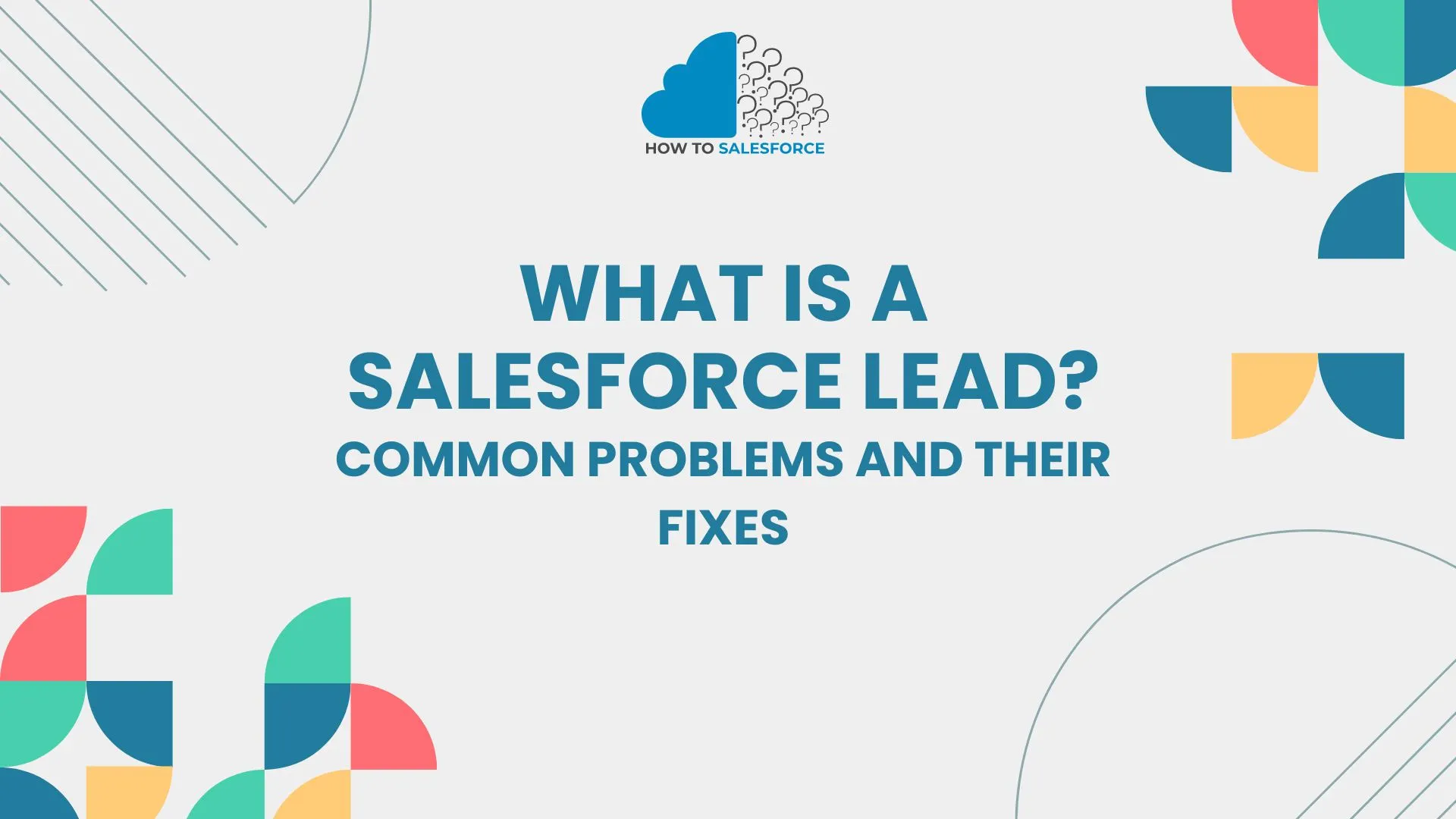In the fast-paced, competitive world of customer relationship management (CRM), knowing leads is crucial to corporate success. What is a Salesforce lead is, how important it is, and how it can transform and improve your sales operations to previously unheard-of levels of productivity and success are all covered in this in-depth essay.
Are you a newbie in Salesforce? Here is your complete guide that helps you to Find out Your Salesforce Niche.
Comprehending Salesforce Leads
What Is a Lead in Salesforce?
The leads are companies or individuals that are interested in your product or service but haven’t purchased it. Leads from many sources start the sales process.
- Website queries
- Social media exchanges
- Trade exhibitions
- Recommendations
- Email campaigns
- Webinars and events
- Advertising campaigns
Qualities of a Prospect Salesforce User
A lead usually has the following general information:
- Name – Contact information (phone, email)
- Details about the company: lead source and lead status (New, Contacted, qualified, or unqualified).
- Lead owner, who is tasked with selling
Salesforce Lead Types
There are two primary categories of leads to consider:
- Cold Leads: Although they initially showed interest, these leads have not interacted with your brand extensively.
- Warm Leads: These leads are more likely to become customers because they have demonstrated a higher level of engagement and interest.
The Value of Leads from Salesforce
Promoting Sales Expansion
Leads are vital to sales growth because they might become devoted clients. Your lead management may greatly affect your sales.
- Expands the pool of possible clients
- Fine-tunes sales targeting
- Boosts revenue potential by improving lead conversion
Boosting Promotional Activities
Being aware of what a Salesforce lead is makes it easier to tailor marketing strategies that attract and involve potential customers. Customized material, marketing targeting, and careful follow-ups are all part of this.
- Facilitates accurate marketing campaign targeting
- Offers insights for customized content
- Permits more efficient remarketing initiatives
Strengthening Connections with Customers
Companies can improve their relationships with potential customers by quickly meeting their needs and handling their concerns when they handle their leads well. This can make customers happier and increase the number of people who buy something.
- Establishes rapport and trust with prospective clients
- Makes sure that follow-up and engagement happen on time
- Proactively attends to client needs
How to Establish a Lead in Salesforce
Input via Hand
You can directly add leads in Salesforce by filling out the lead form with the right information. This is something that salespeople often do after their first meeting with a possible client.
- Guarantees the accuracy of the lead data
- Enables comprehensive annotations and assessments
- Beneficial for leads from face-to-face meetings
Bringing in Leads
Results from sources outside of the company, such as:
- CSV files
- Platforms for marketing automation
- Additional CRM systems
The Import Leads Steps:
- Create a CSV file with your data.
- Associate your file’s fields with Salesforce lead fields.
- To import the leads, use the Data Loader or Salesforce Data Import Wizard.
Lead Capture Automation
To make sure that no possible lead is missed, Salesforce lets you automatically collect leads from your website, email marketing, and social media outlets.
- On-page Web-to-Lead forms
- Email integration for response collection
- Social media techniques for capturing leads
Effectively Managing Salesforce Leads
Lead Task
It’s best to use these rules to choose which salespeople should get leads:
- Lead score
- Product interest
- Industry
- Geography
Lead Assignment Methods:
- The round-robin task
- Assignment depending on territory
- Task dependent on skills
Lead Evaluation
Each lead is given a number based on how interested they are and how likely they are to become a customer. This is called lead scoring. These things can change lead scores:
Frequency of interactions
- Demographic data
- Behavioral information
- Content engagement (clicks, opens, and downloads)
Developing Prospects
To generate leads, you need to make links by:
- Consistent follow-ups
- Customized electronic mail
- Content advertising
Practical Lead Nurturing Techniques:
- Email drip campaigns
- Tailored content suggestions
- Specific social media exchanges
Analytics and Tracking
It has a lot of data and tracking tools that can be used to look at lead activity and performance and make planning better to get better results.
- Monitoring lead activity (calls, meetings, emails)
- Performance indicators (time to conversion, conversion rates)
- Dashboards and reporting for in-the-moment insights
Turning Leads into Sales
Qualification Procedure
There are some leads that aren’t ready to buy right away. During the screening process, leads are checked to see which ones are ready to be sold by:
- Lead score; Budget; Authority; Need; Timeline (BANT);
Methods of Qualification:
- First calls for discovery
- Needs assessment questionnaires
- Alignment sessions between marketing and sales
Transforming Prospects into Opportunities
Salesforce allows you to turn a lead into a chance after it has been checked out. This process includes the following:
- Adding information about the lead to the opportunity record
- Changing the lead’s status
- Giving the sales staff the opportunity
- Making follow-up tasks and reminders
Concluding the Order
In the last step, the sale is completed by:
- Making a strong proposal
- Responding to criticism
- Getting the agreement
- Monitoring to make sure the client is satisfied
A Guide to Concluding the Sale:
- Emphasizing value propositions
- Providing rewards or savings
- Offering case studies and references
Salesforce Lead Management Best Practices
Frequent Data Purification
It is very important to keep lead info correct and up-to-date. To keep your data safe, get rid of copies, update contact information, and store leads that are no longer valid on a frequent basis.
- Arrange for recurring data reviews.
- Apply data validation guidelines
- Utilize tools for data enrichment
Regular Follow-Ups
Following up is important for gathering leads. Use Salesforce tasks and reminders to ensure prompt follow-ups and prevent leads from being overlooked.
- Establish follow-up alerts
- Employ task-management software
- Set up recurring emails
Making the Most of Salesforce Integrations
Connect other tools, like social media outlets, email marketing software, and marketing automation platforms, to Salesforce to boost productivity and make lead handling more effective.
- Automated marketing (Marketo, Pardot)
- Email marketing with Constant Contact and Mailchimp
- Social media administration with Sprout Social and Hootsuite
Making Use of Salesforce Dashboards and Reports
You can change the screens and data in Salesforce to track the success of leads, see how many of them turn into customers, and find places where things could be better. Read these tips over and over to get the most out of your lead management plan.
- Make unique reports for lead metrics
- Get real-time information from dashboards
- Distribute reports to the marketing and sales departments.
Typical Problems and Their Fixes
Challenge 1: Poor Lead Quality
Solution: To improve lead quality, you should focus on getting leads from good sources, use lead scores, and fine-tune your targeting strategies.
- Execute focused advertising campaigns
- Prioritize high-quality leads with lead scoring
- Collaborate with reliable lead generation providers
Challenge 2: Lead Seepage
Solution: Automatically collect leads, ensure their proper distribution, and establish follow-up notes to prevent lead loss.
- Employ web-to-lead forms.
- Put in place automatic lead routing
- Establish follow-up procedures
Challenge 3: Ineffective Lead Nurturing
Solution: To improve lead nurture, use marketing automation, make unique content for each lead, and stay in touch with them all the time.
- Create customized email marketing
- For constant interaction, use marketing automation
- Divide up leads for focused nurturing
Challenge 4: Inadequate Data Administration
Solution: As well as other best practices for data management, use tools for adding to data, rules for making sure data is correct, and regular data cleaning.
- Plan frequent data audits.
- Adopt guidelines for data validation
- Make use of data enrichment services
Conclusion
Understanding the concept of a Salesforce lead is important for optimizing sales processes and driving business growth. You can increase customer happiness, boost your sales funnel, and boost conversion rates by managing leads well, building relationships, and utilizing Salesforce’s robust features. Discover the transformative impact that lead management can have on your company by prioritizing it today.


